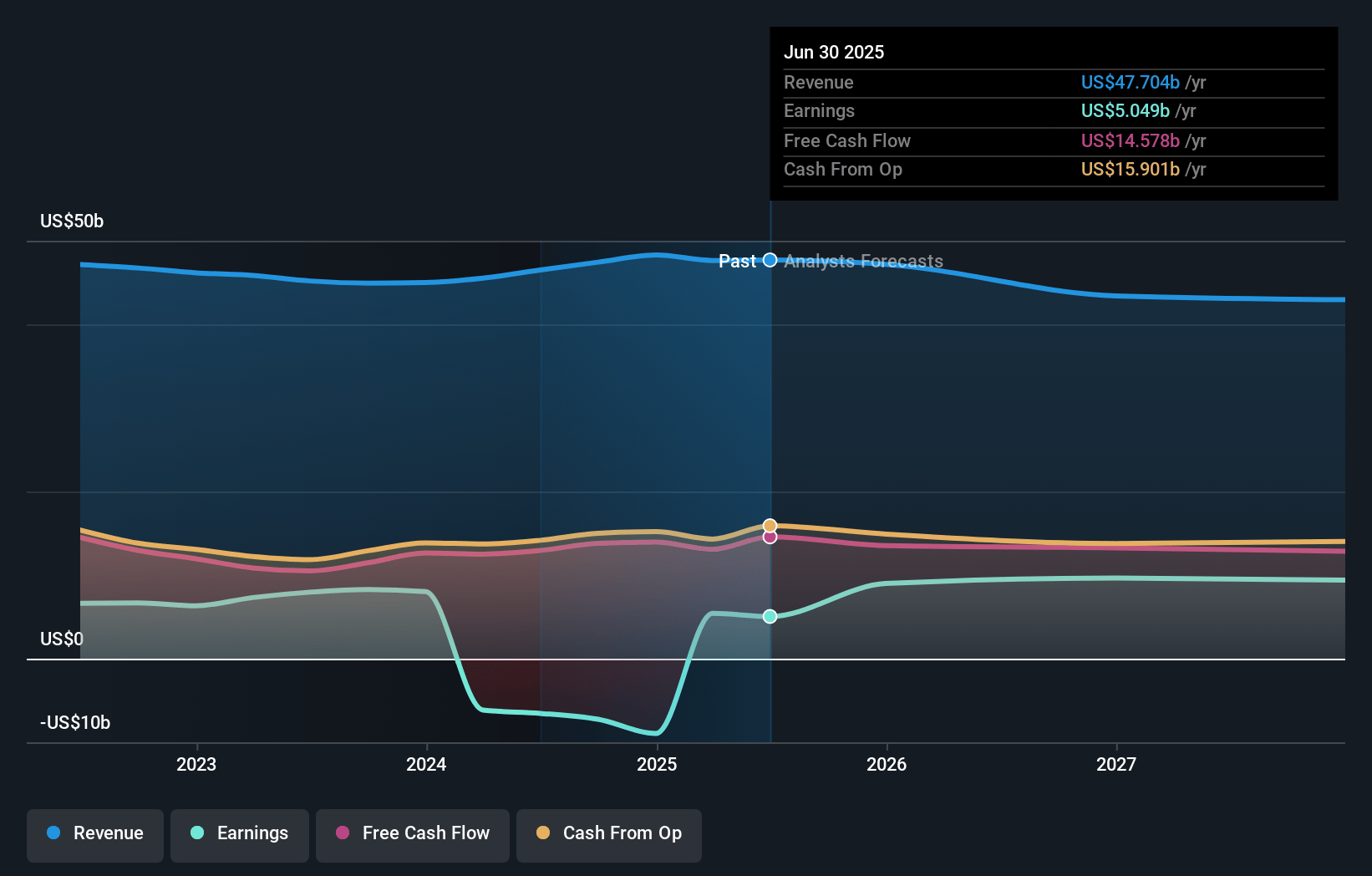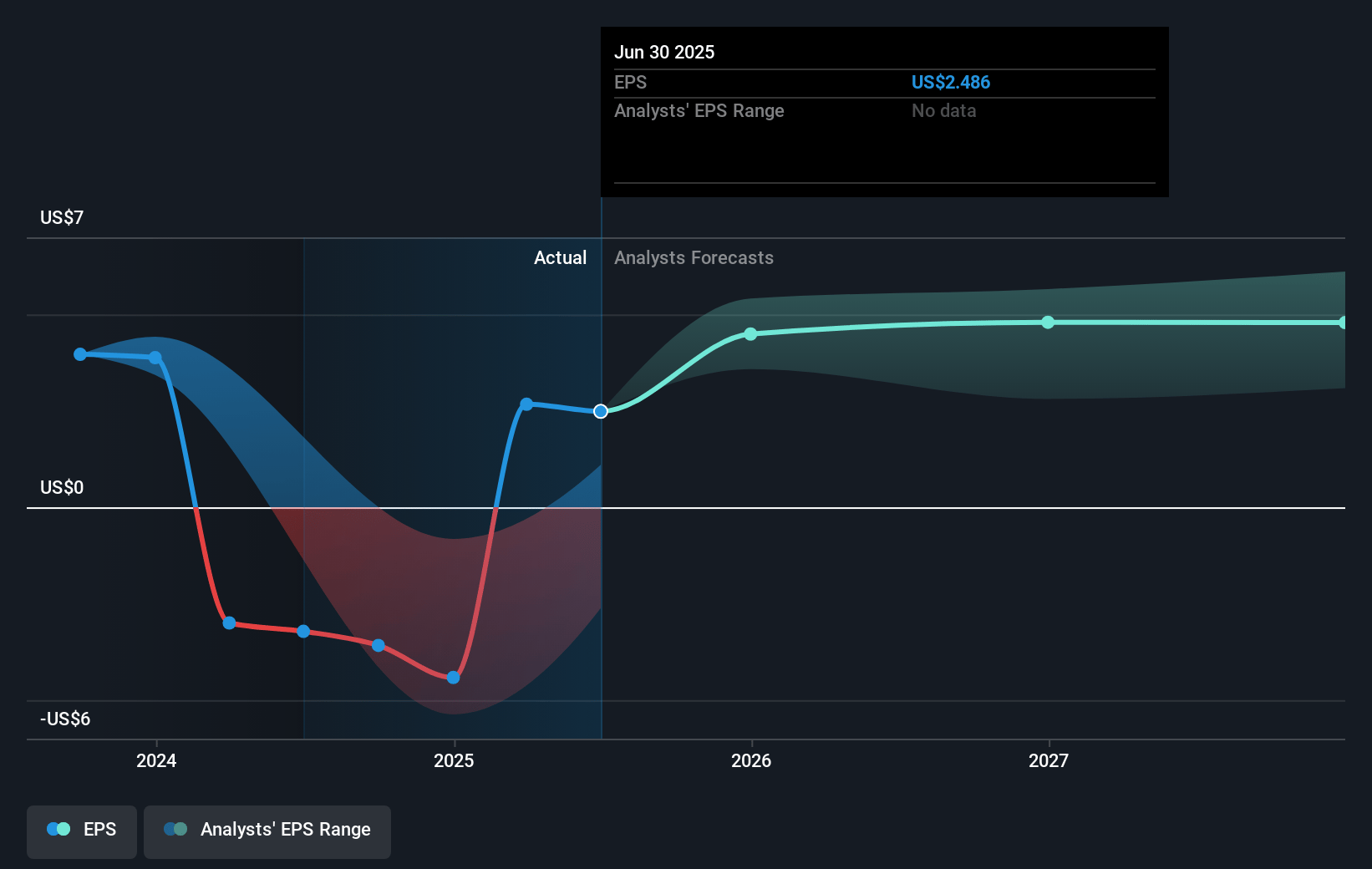Key Takeaways
- Expansion in market acceptance and international approvals of key products drives robust growth, bolstered by promising new indications and oncology programs.
- Strategic cost efficiency and robust capital allocation efforts enhance financial performance and support sustained earnings growth through 2025.
- Failures in key studies and increasing competition may challenge revenue growth, while economic and regulatory uncertainties threaten margins and financial stability.
Catalysts
About Bristol-Myers Squibb- Bristol-Myers Squibb Company discovers, develops, licenses, manufactures, markets, distributes, and sells biopharmaceutical products worldwide.
- Bristol-Myers Squibb's growth portfolio, including key products like Cobenfy, Opdivo Qvantig, Breyanzi, Reblozyl, and Camzyos, is expected to drive significant revenue growth due to their expanding market acceptance and international approvals.
- The company's robust pipeline, with upcoming pivotal studies and several data readouts, promises long-term growth potential. Key developments include Cobenfy's potential new indications in Alzheimer's disease and new oncology programs, which could enhance future revenue.
- Efforts to optimize operational efficiency, such as the strategic productivity initiative aimed at $2 billion in annual cost savings by 2027, are anticipated to improve net margins and overall financial performance.
- Bristol-Myers Squibb's strategic capital allocation, including investments in R&D and potential business development initiatives, reflects a commitment to enhancing its growth outlook, which could positively impact earnings.
- The company's focus on operational excellence and cost structure optimization, alongside strong execution across its therapeutic areas, positions it for sustained EPS growth, evidenced by its increased guidance for 2025.
Bristol-Myers Squibb Future Earnings and Revenue Growth
Assumptions
How have these above catalysts been quantified?- Analysts are assuming Bristol-Myers Squibb's revenue will decrease by 4.2% annually over the next 3 years.
- Analysts assume that profit margins will increase from 11.4% today to 23.4% in 3 years time.
- Analysts expect earnings to reach $9.8 billion (and earnings per share of $4.89) by about May 2028, up from $5.4 billion today. However, there is a considerable amount of disagreement amongst the analysts with the most bullish expecting $12.2 billion in earnings, and the most bearish expecting $6.3 billion.
- In order for the above numbers to justify the analysts price target, the company would need to trade at a PE ratio of 14.4x on those 2028 earnings, down from 17.9x today. This future PE is lower than the current PE for the US Pharmaceuticals industry at 16.8x.
- Analysts expect the number of shares outstanding to grow by 0.39% per year for the next 3 years.
- To value all of this in today's terms, we will use a discount rate of 6.21%, as per the Simply Wall St company report.
Bristol-Myers Squibb Future Earnings Per Share Growth
Risks
What could happen that would invalidate this narrative?- The failure of the Camzyos ODYSSEY study in non-obstructive HCM may limit the growth potential and peak sales of Camzyos, impacting long-term revenue projections.
- The failure of the Cobenfy ARISE study to meet its primary endpoint in adjunctive schizophrenia may challenge the commercial strategy and projections for expanding Cobenfy’s market share, potentially affecting future earnings from this product.
- Increasing competition from alternatives like aficamten in the heart failure space may impact Camzyos' market position and future revenue.
- Economic uncertainties, tariffs, and potential global supply chain disruptions may impact margins and overall financial stability.
- Uncertain regulatory environment and potential changes to U.S. and international drug pricing policies may adversely affect the company’s revenue and profit margins.
Valuation
How have all the factors above been brought together to estimate a fair value?- The analysts have a consensus price target of $57.202 for Bristol-Myers Squibb based on their expectations of its future earnings growth, profit margins and other risk factors. However, there is a degree of disagreement amongst analysts, with the most bullish reporting a price target of $68.0, and the most bearish reporting a price target of just $36.0.
- In order for you to agree with the analyst's consensus, you'd need to believe that by 2028, revenues will be $41.8 billion, earnings will come to $9.8 billion, and it would be trading on a PE ratio of 14.4x, assuming you use a discount rate of 6.2%.
- Given the current share price of $47.57, the analyst price target of $57.2 is 16.8% higher.
- We always encourage you to reach your own conclusions though. So sense check these analyst numbers against your own assumptions and expectations based on your understanding of the business and what you believe is probable.
How well do narratives help inform your perspective?
Disclaimer
AnalystConsensusTarget is a tool utilizing a Large Language Model (LLM) that ingests data on consensus price targets, forecasted revenue and earnings figures, as well as the transcripts of earnings calls to produce qualitative analysis. The narratives produced by AnalystConsensusTarget are general in nature and are based solely on analyst data and publicly-available material published by the respective companies. These scenarios are not indicative of the company's future performance and are exploratory in nature. Simply Wall St has no position in the company(s) mentioned. Simply Wall St may provide the securities issuer or related entities with website advertising services for a fee, on an arm's length basis. These relationships have no impact on the way we conduct our business, the content we host, or how our content is served to users. The price targets and estimates used are consensus data, and do not constitute a recommendation to buy or sell any stock, and they do not take account of your objectives, or your financial situation. Note that AnalystConsensusTarget's analysis may not factor in the latest price-sensitive company announcements or qualitative material.





